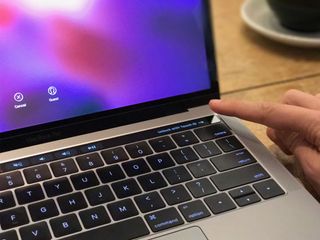Fusing the Mac, or slipping a LITTLE ARM inside

Mark Gurman and Ian King, writing for Bloomberg:
Apple Inc. is designing a new chip for future Mac laptops that would take on more of the functionality currently handled by Intel Corp. processors, according to people familiar with the matter.The chip, which went into development last year, is similar to one already used in the latest MacBook Pro to power the keyboard's Touch Bar feature, the people said. The updated part, internally codenamed T310, would handle some of the computer's low-power mode functionality, they said. The people asked not to be identified talking about private product development. It's built using ARM Holdings Plc. technology and will work alongside an Intel processor.
And:
The development of a more advanced Apple-designed chipset for use within Mac laptops is another step in the company's long-term exploration of becoming independent of Intel for its Mac processors. Apple has used its own A-Series processors inside iPhones and iPads since 2010, and its chip business has become one of the Cupertino, California-based company's most critical long-term investments.
Now — and I'm just spit-balling here — imagine this is something beyond the whole Intel/ARM question. (Apple has been prototyping ARM-based Macs for years, after all).
Imagine it's an extension of the "fusion" architecture that Apple's been increasingly using across their products and services. Fusion Drive melds high-capacity platters with high-speed solid state. iCloud Libraries do something similar but meld online and local storage. The iPhone 7 Plus camera melds a wide-angle with a telephoto lens.
A better example is the A10 system-on-a-chip, though, which Apple went so far as to brand "Fusion". When Apple made the main A10 cores, they noticed it was so high-performance it actually made lower-performance tasks less efficient. So, to fill the space left beneath it, Apple added a second set of lower-performance, more power efficient cores. The result was Apple's first big.LITTLE chipset.
For several generations now, though, Apple has also been doing sensor fusion hubs by including the M-series co-processors — originally alongside but now integrated into — the A-series. That lets them do things like track motion more power efficiently.
The T1 system-in-package on the MacBook Pro is another example. The Mac controls the majority of the Touch Bar but the T1 SIP handles Touch ID, Apple Pay, and displaying any and all related data.
Master your iPhone in minutes
iMore offers spot-on advice and guidance from our team of experts, with decades of Apple device experience to lean on. Learn more with iMore!
Power efficiency is Apple's jam. Unless and until they license x86 or swap MacBook to ARM, there's only so much even the tight and belabored integration they do with Intel will deliver them.
Offloading low-power, low-level tasks to their own silicon, though, is absolutely something Apple could and would do regardless of the main processor architecture. Same as they could and did offload display to their own, custom timing controller when they wanted to bring 5K to the iMac and the industry just hadn't gotten there yet.
I wouldn't be surprised to see Apple take on more and more of the silicon inside all of their devices as time goes on. Modems, graphics processors, central processors — with the team they have in place, there's no limit to what they can do other than what makes sense to them and what they choose to focus on at any given point in time.
Like I said when Apple's first wireless chip, W1 was introduced...

Rene Ritchie is one of the most respected Apple analysts in the business, reaching a combined audience of over 40 million readers a month. His YouTube channel, Vector, has over 90 thousand subscribers and 14 million views and his podcasts, including Debug, have been downloaded over 20 million times. He also regularly co-hosts MacBreak Weekly for the TWiT network and co-hosted CES Live! and Talk Mobile. Based in Montreal, Rene is a former director of product marketing, web developer, and graphic designer. He's authored several books and appeared on numerous television and radio segments to discuss Apple and the technology industry. When not working, he likes to cook, grapple, and spend time with his friends and family.